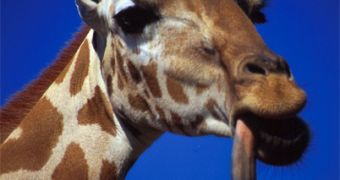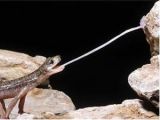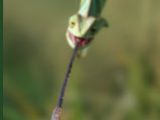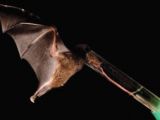Tongue is an organ specific to the vertebrates. And they can do a lot of things with their tongues...
1. A blue whale weighing 60-70 tons (and the largest blue whales can double this weight) has a 3 tons tongue. It is by far the largest tongue in the animal world. And the whale tongue is not large because of the overall size of the animal; right whales have extremely oversized tongues for their bodies, because they use their tongues like scoops while filtering the food in their huge mouths. 50 people could stand on the tongue of a blue whale.
2. The most famous tongue of the animal world is that of the chameleon. It is the longest in the world, comparing with the body length - in most species it is as long as the body and tail together. The tongue is launched and put back in a fraction of a second (0.04 s the launch (!), 0.5 s the put back). No wonder a chameleon can catch 4 flies in 3 seconds...
The tongue is like a long tube finished in a sticky bulb, due to the mucus secreted by glands located in its tip. The resting tongue is folded like an accordion around a bone called Processus entoglossus. For stretching the tongue during the hunt, the animal must relax longitudinal muscles that act like a spring.
Chameleons hunt mainly insects (including bees and wasps that do not have time to employ their defensive stings because of the velocity of the tongue), spiders and even small birds and rodents in the case of the largest species, than can be 70 cm (two feet) long. If the prey is located out of the tongue's range, the chameleon approaches slowly and patiently, to the point where it can trigger the tongue weapon efficiently.
3. But the technique of the chameleon is not specific to it. Exactly the same method of catching the prey is employed by a group of salamanders from the Americas, belonging to the Plethodontidae family. Species of 6 cm (2.4 in) have 5 cm (2 in) long tongues, the longest in the world of the amphibians.
Moreover, the giant palm salamander of Central America (Bolitoglossa dofleini) shoots out its tongue with the fastest speed developed by any known muscle in the vertebrates. The species can shoot out its tongue at 18,000 watts of power per muscular kilogram.
Bolitoglossa extends its tongue (which measures more than half of its body length) in about 7 milliseconds, 50 times faster than an eye blink.
The fact that the tongue is propelled outward much faster than by sheer muscle contraction shows that there must be an unknown elastic tissue connected to the salamander's tongue, which stores up the energy amounts required by the explosive projection. The trajectory is sustained by cartilages integrated in the structure of the tongue. The process can be compared to the stretching and shooting of a rubber band: the recoil occurs faster than the act of releasing a rubber band pulled taut: the amount of energy doesn't change; it's just released faster.
Tongue-launching systems found in other species is formed by three components: a motor to produce energy, a spring to store it and a latch to control the unloading of the spring, but so far only the motor in the salamander system has been found.
4. The tongue of the giant pangolin (which is no longer than 1 m (3.3 ft)) is 70 cm (2.3 ft) long! The unique fact amongst all vertebrates, its muscle roots pass through the whole body of the animal, anchoring to the pelvis bone of the animal (in the genital area)! All pangolin species have such long tongues, which they insert inside termite and ant mounds while feeding.
5. The tongue of the giraffe is 54 cm (1.8 ft) long, being the most powerful and muscular amongst all hoofed mammals. The tongue and the roof of the mouth are so tough, that the giraffes can feed on the leaves of the thorniest Acacia trees. Giraffes can scratch and lick all their face using their tongues.
The Sun bear (Helarctos malayanus) of Southeast Asia is the smallest bear species, but it has the longest tongue of all carnivorous mammals, up to 10 cm (25 cm) long.
6. In some languages, there is the expression "like having bones in the tongue". This actually exists: the fish of the Osteoglossiformes group actually have bones in the tongue. (Osteoglossus means "bonny tongue" in Latin). The most famous species of the group is the giant arapaima (Arapaima gigas) of the Amazon River, which can grow up to 4.5 m (15 ft) in length and weigh 200 kg (440 lbs).
7. The tube-lipped nectar bat (Anoura fistulata) of the Ecuadorian mountains has the size of a mouse, but its 8.5 cm (3.4 in) long tongue is 1.5 times longer than its body and more than double than the tongue-length of similar nectar bats. The bat is related to the infamous vampire bat.
Compared with its body, this tongue is second only after the chameleon in terms of vertebrates, and it is the longest of all the mammals. Nectar bats' tongues have tiny hairs on the end, which they use to mop up nectar and pollen of the flowers. The plants gain from this relationship by depositing pollen on the bat's head, which it spreads from flower to flower.
Despite its exceptionally long tongue, the tube-lipped nectar bat has a varied diet that also includes insects. This is possible due to its short jaw; the base of the tongue is in the bat's rib cage. The bat, which stows its lengthy tongue in its rib cage, pollinates a plant with corollas of the same length, Centropogon nigricans.
8. Mollusks have an organ similar to the tongue of the vertebrates, called radula. The radula of the garden snails wears up to 14,175 teeth!
9. The tongue of the alligator snapper turtle (Macrochelys temminckii) looks like a red, wormlike appendage employed for attracting prey. The turtle lies on the bottom of the water, opening widely its jaws and wiggling the "worm". Fishes enter the turtle's mouth to grab the bait, and the turtle snaps its mouth shut.
10. The flamingo tongues function just like ... penises! They have erectile tissue. These birds feed only in shallow waters. Flamingos introduce their beak into water, tilted upside down, and move their heads from side-to-side. Their tongues function like pumps, sucking water into the front of the bill and then squeezing it out through the sides, in a rhythm of 20 times per minute.
Fringed plates on their tongues trap algae and little crustaceans from the circulating water. When the large oval masses of erectile tissue on the mouth floor on the tongue's sides fill with blood, they stiffen, strengthening and supporting the floor of the mouth and the tongue; the same effect causes erections in man's penis. Flamingo's erectile tissue confers stability, as the birds stay with the heads upside down into the water to suck up food. Unlike a bony element, this erectile tissue is something that can be used on demand and can go away when not needed.

 14 DAY TRIAL //
14 DAY TRIAL // 



